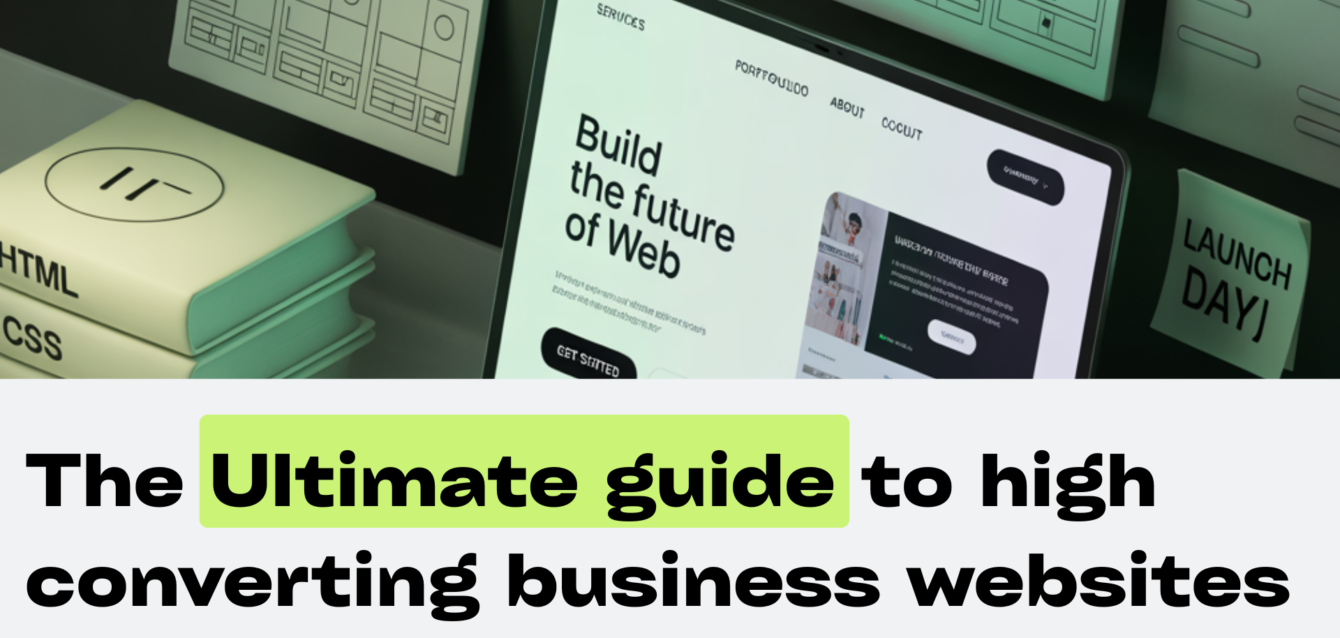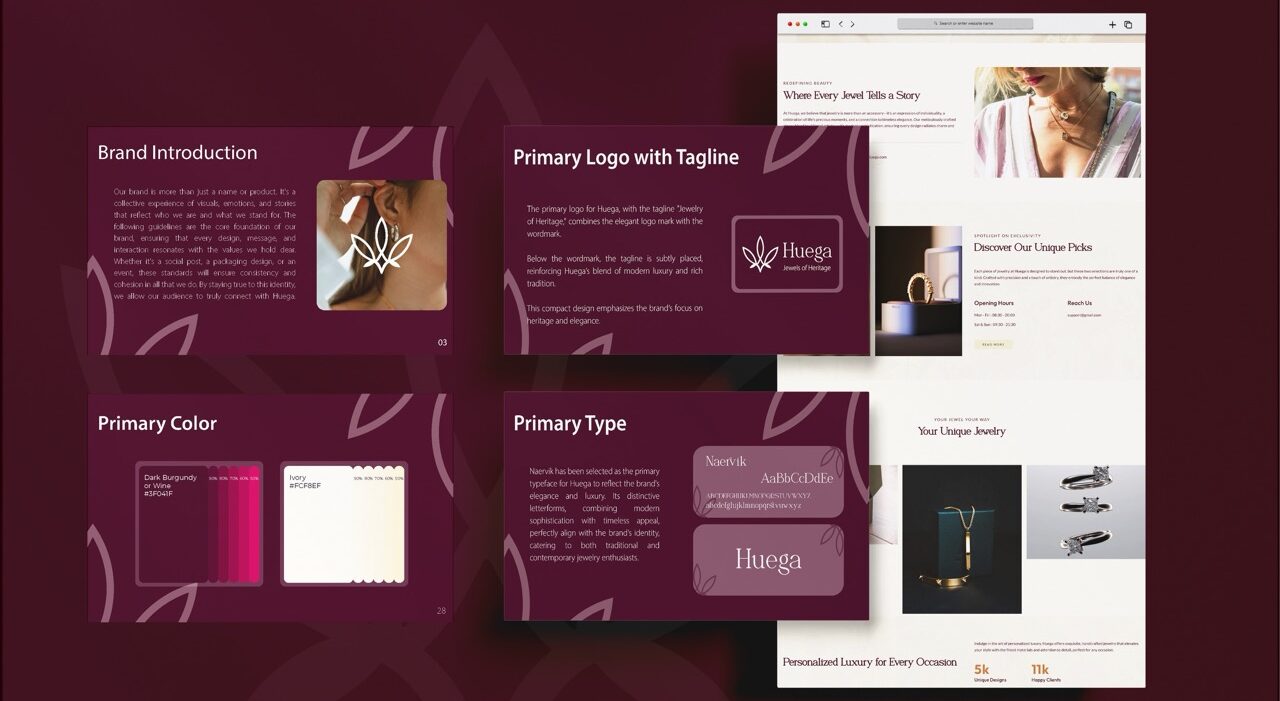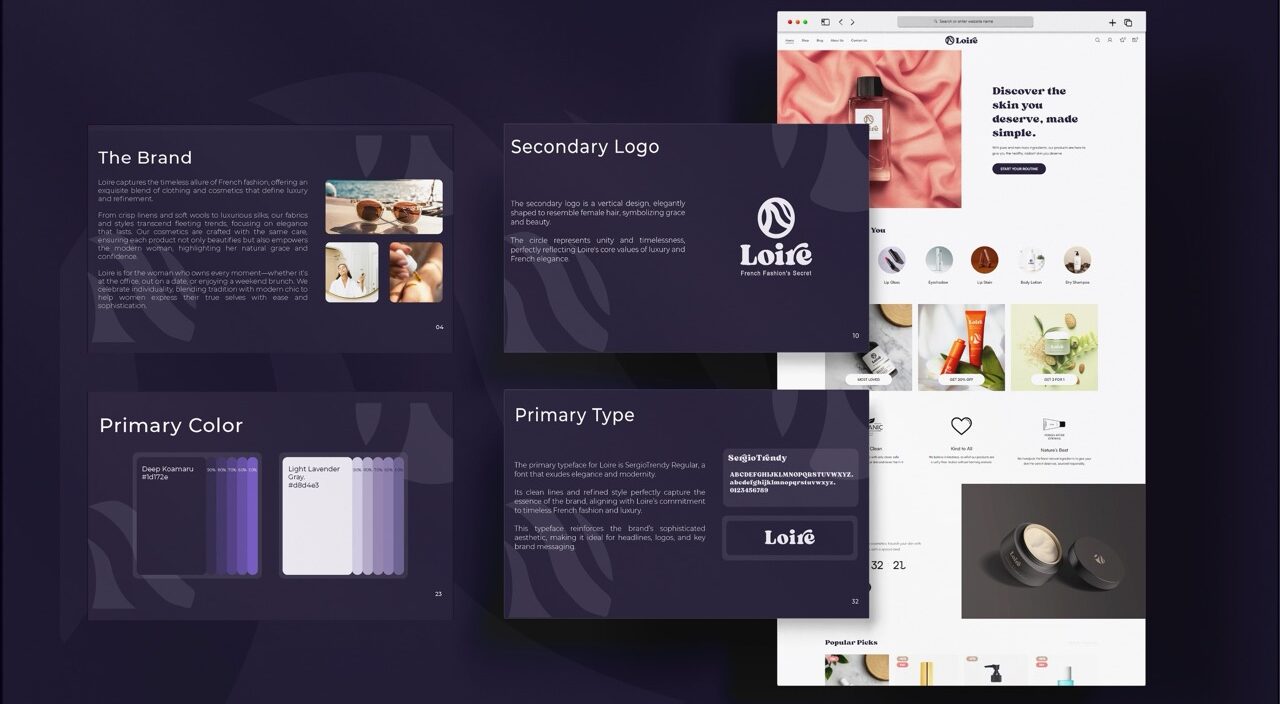For most businesses today, your website is your digital global storefront, your lead generation engine, and your most persistent salesperson. But is it pulling its weight? Is it just a beautiful, passive online brochure, or is it an active, relentless growth machine for your company? This guide is your complete, strategic roadmap to building a business website that doesn’t just attract visitors, but systematically converts them into loyal, paying customers.
TL;DR: Your 2-Minute Blueprint for a Website That Sells
Stop making random, disconnected website updates. A winning business website is a cohesive system where every single element, every button, image, and headline, is aligned with a specific, measurable business goal. No exceptions.
- Strategy first, production second. Before you obsess over fonts and colors, you must build a plan based on these 8 pillars: Foundation, User Experience (UX), Copywriting, SEO/CRO, Performance, Visual Design, Landing Pages, and Homepage Structure.
- Clarity is your most powerful conversion tool. If a first-time visitor can’t understand what you do, who it’s for, and what’s in it for them within five seconds, you have already lost their attention. You must speak directly to their problems and offer an immediate, clear solution.
- Don’t make users think. The path from visitor to lead or customer should be intuitive and frictionless. Any confusion, doubt, or difficulty in navigation is a leak in your revenue bucket. Your goal is to make the desired action the easiest and most obvious choice.
- Measure what matters most. Forget vanity metrics like raw traffic numbers. Focus on the data that proves business impact: conversion rate, cost per lead, and pipeline influence. That’s the website ROI your leadership team actually cares about.
Why a High-Converting Website Is Your Most Valuable Business Asset
Let’s be brutally honest. If you’re a business leader or marketer in 2025, you know a website is essential. You have one. You’ve likely invested a significant amount of time, money, and energy into it.
But here’s the nine-figure question: is it actually working?
Too often, companies treat their website as a one-off project. They go through a big, expensive redesign, launch it with fanfare, and then let it sit, largely unchanged, for the next three years. The result is a static, depreciating asset that fails to move the needle on real business goals. It’s a collection of pages, not a conversion-focused web design. If this situation sounds painfully familiar, you are in the right place.
A high-converting business website is no longer optional; it is the absolute centerpiece of modern growth strategy. The fundamental shift is from having a passive online presence to engineering a powerful digital experience that predictably guides your ideal customers from their first casual glance to a final, confident purchase. This guide is your comprehensive blueprint for making that happen.
We are going to walk you through a proven, step-by-step framework to plan, build, and relentlessly optimize a site that delivers measurable, predictable results. This journey begins with a critical mindset shift: your website’s job isn’t just to look good. Its primary job is to build trust and drive action at scale.
Step-by-Step: The 8 Core Pillars of a Website That Drives Relentless Growth
A website that generates leads isn’t the result of luck or magic. It’s a carefully architected system. We’ve distilled this system into 8 core pillars that will transform a blank page or an underperforming site into a fully operational conversion machine. When you approach your website strategy this way, every single pixel has a purpose.
Before you can build a house, you must lay a solid foundation. The same is true for your website. Without these core elements firmly in place, any advanced strategies you try will be built on shaky ground. These are the absolute, non-negotiable fundamentals.
The most critical element is a Crystal-Clear Value Proposition. This is your promise to the customer, and it must be understood in seconds. It should live “above the fold” on your homepage and answer three questions: What do you do? Who is it for? And why are you the best choice? A great template is Geoffrey Moore’s: “For [target customer] who [statement of need or opportunity], our [product/service name] is a [product category] that [statement of key benefit].”
Next are Compelling Calls-to-Action (CTAs). You cannot expect users to know what to do next; you must guide them. Vague CTAs like “Submit” or “Learn More” are weak. Strong CTAs use action-oriented, value-driven language like “Get Your Free Marketing Plan” or “Start My 30-Day Trial.” They should be visually prominent, typically in a color that contrasts with your site’s main palette.
Finally, you need Overwhelming Social Proof and Trust Signals. People are inherently skeptical online. You must proactively dismantle that skepticism. This includes customer testimonials, logos of well-known clients, star ratings, case studies, and security badges (like SSL certificates). Placing these trust signals near key decision points (like a “Buy Now” button or a form) can significantly increase conversion rates.
[Actionable Guide: Get the full checklist in our deep dive on the Top 10 Elements Every High-Converting Website Must Have]
User Experience (UX) is the overall feeling a person has while interacting with your website. It’s the sum of all parts. To be clear, UX is not the same as User Interface (UI). The UI is the set of buttons, screens, and visual elements. The UX is the entire experience of using them. A beautiful UI on a confusing website is like a beautiful saddle on a horse you can’t ride.
A core principle of good UX is minimizing cognitive load, the amount of mental effort required to use your site. When users are confused by unclear navigation, inconsistent layouts, or the paradox of too many choices, their cognitive load increases, and they are far more likely to abandon the site.
Achieving great UX requires stepping into your customer’s shoes through tools like user personas (fictional profiles of your ideal customers) and user journey mapping (visualizing the path a user takes to accomplish a goal). This process uncovers “friction points” areas of frustration that cause users to drop off. Is your checkout process too long? Is your pricing page confusing? Fixing these friction points is central to improving website conversions.
[Deep Dive: Learn how a frictionless user journey directly impacts sales in How Website UX Design Impacts Conversion Rates]
Your website’s copy is your 24/7, top-performing salesperson. It must do more than just describe; it must persuade. The biggest mistake in business website strategy is writing copy that is company-centric (“We are proud to offer…”) instead of customer-centric (“You will finally be able to…”).
To craft copy that converts, focus on Benefits over Features. A feature is what your product is (e.g., “a 1-inch drill bit”). A benefit is what the customer gets because of that feature (e.g., “a 1-inch hole”). Customers buy the outcome, not the tool.
A powerful copywriting framework to structure your pages is AIDA:
- Attention: Grab them with a powerful, benefit-driven headline.
- Interest: Build interest by elaborating on the problem and showing empathy.
- Desire: Create desire by painting a picture of the “after” state, the better life or business your customer will have thanks to your solution. Use testimonials and case studies here.
- Action: Compel them to take the next step with a clear, urgent Call-to-Action.
Finally, use Voice of Customer data. Scour your customer reviews, support tickets, and sales calls for the exact words and phrases your customers use to describe their problems and desired outcomes. Weaving this real language into your website copy makes it instantly more relatable and trustworthy.
[Become a master persuader with our guide on Website Copy That Converts: Writing to Win Customers]
Many businesses treat Search Engine Optimization (SEO) and Conversion Rate Optimization (CRO) as separate disciplines. This is a massive strategic error. They are a powerful partnership that, when combined, drives incredible website ROI optimization.
Think of it like this: SEO gets people to the party. CRO makes sure they have a great time, stay, and mingle.
- SEO is the process of earning traffic from search engines. It’s about understanding user intent and creating relevant, authoritative content that ranks for key search terms.
- CRO is the process of converting that traffic into action. It’s the science and art of making your website more effective at achieving its goals.
Here’s how they create a virtuous cycle: SEO data can inform your CRO efforts. If a page gets tons of traffic but has a very high bounce rate, that’s an SEO signal telling you to focus your CRO efforts on that page. As you use CRO to improve the page-making it clearer, faster, and more persuasive, user engagement metrics like “time on page” and “bounce rate” will improve. Google sees these positive engagement signals and may reward your page with better rankings. One feeds the other.
[Unpack this essential partnership for growth in SEO vs CRO: What Really Drives Website ROI?]
Website performance, particularly page load speed, is no longer a secondary concern for the IT department. It is a primary driver of conversion and revenue. Google’s own data shows that the probability of a user bouncing increases by over 30% as page load time goes from 1 to 3 seconds. For e-commerce, the numbers are even more stark.
For a modern website, you must be aware of Google’s Core Web Vitals:
- Largest Contentful Paint (LCP): How long it takes for the main content of the page to load. (Aim for under 2.5 seconds).
- First Input Delay (FID): How long it takes for your site to respond to a user’s first interaction (like a click). (Aim for under 100 milliseconds).
- Cumulative Layout Shift (CLS): How much the page layout unexpectedly moves around as it loads. (This is what happens when you try to click a button and an ad loads, shifting it down).
The primary culprits of poor performance are almost always large, unoptimized images, bloated code (from too many plugins or poor development), and slow server response times (cheap hosting). Compressing images, using next-gen formats like WebP, and investing in quality hosting are not costs; they are investments in higher conversion rates.
[Discover the direct financial impact of a fast website in Speed = Sales: Why Website Performance Impacts Conversion]
Effective web design is not about decoration; it’s about communication and guidance. Your site’s visual elements are a powerful tool for directing user attention and making your core message easier to digest.
A key concept is Visual Hierarchy. This is the principle of arranging elements to show their order of importance. You achieve this through size (bigger headlines are more important), color (a bright CTA button stands out), and negative space (whitespace around an element gives it prominence). This isn’t arbitrary; it leverages how people naturally scan web pages, often in an “F-Pattern” (reading across the top, then down the left side). You should place your most critical information along this natural path.
Furthermore, use imagery strategically. Ditch the cheesy, generic stock photos. Use high-quality, authentic photos of your team, your product in action, or your customers. This builds trust and authenticity far more effectively than a photo of perfectly multicultural models laughing at a salad.
[Learn the psychological principles behind effective layouts in How to Use Visual Design to Guide User Behavior]
A landing page is a specialized, standalone page created for a specific marketing campaign. When a user clicks your Google Ad or a link in an email, they should arrive here. Its sole purpose is to convert that visitor for one specific offer.
The single most important principle for a high-converting landing page is Message Match. The headline and promise of your ad must be immediately reflected in the headline and promise of your landing page. If there is a disconnect, users will feel confused or misled and will instantly bounce.
An effective landing page has a 1:1 attention ratio – one goal, one message, and one primary call-to-action. It should be stripped of all distractions, including the main site navigation menu. Its core components are a compelling headline, a supporting sub-headline, a hero shot (an image or video showing context), a clear list of benefits, social proof, and a single, unmissable CTA.
[Plug the leaks in your marketing funnel by avoiding these Landing Page Design: 7 Mistakes That Kill Conversions]
Your homepage is your digital lobby and your most valuable online real estate. It needs to serve multiple audiences and guide them to the right place. It must be structured to tell a compelling story as the user scrolls.
A high-converting homepage structure typically flows like this:
- The Hero Section (Above the Fold): This contains your value proposition, a supporting image/video, and your primary CTA. Its only job is to get the user to understand what you do and want to scroll down.
- The Social Proof Bar: Immediately below the hero, show logos of well-known clients or impressive metrics (“Trusted by 50,000+ users”) to build instant credibility.
- The Problem & Solution Section: Briefly agitate the primary pain point your customer faces, then introduce your offerings as the solution, focusing on the core benefits.
- The “How It Works” Section: Simplify your process into 3-4 easy steps to show that working with you is straightforward.
- The Final CTA: End with a strong, final call-to-action that mirrors the one in your hero section, providing a last chance to convert.
[Build a better entryway with our complete blueprint on How to Structure a Homepage That Converts]
The DNA of Success: What All Great Business Websites Have in Common
Across every industry, the websites that win consistently share three core traits in their DNA:
- They are Obsessively Customer-Centric: Every decision is filtered through the lens of “How does this help our customer solve their problem and achieve their goal?”
- They Pursue Radical Clarity: They relentlessly eliminate jargon, complexity, and ambiguity. They understand that a confused mind always says no.
- They are Data-Driven and Iterative: They are never “finished.” They treat their website as a living project, constantly testing, measuring, and optimizing based on real user data, not internal opinions.
Silent Killers: 3 Strategic Mistakes That Are Destroying Your Website’s ROI
Building a great website is also about knowing what to avoid. These three strategic blunders can sabotage even the most well-intentioned efforts:
- Designing by Committee: When everyone has a say, the result is a compromised, unfocused design that tries to please everyone and ends up serving no one. A website must have a clear owner and be guided by customer data, not the HIPPO (Highest Paid Person’s Opinion).
- The “Launch and Leave” Mentality: Treating your website as a static project that is “done” after launch is a recipe for failure. Customer expectations and technology change. A website requires ongoing optimization to remain effective.
- Focusing on Vanity Metrics: Being proud of your traffic numbers is like a restaurant being proud of how many people walk past their door. The metrics that matter are the ones that tie directly to business outcomes: conversion rate, lead quality, and revenue influence.
Final Thoughts: Your Website Is a Growth Engine, Not a Static Brochure
Your website should be your hardest-working, most valuable employee. It works around the clock to attract, educate, persuade, and convert customers.
But it cannot achieve this potential by accident. It requires a deliberate, strategic, and ongoing investment in the core pillars of conversion. By shifting your mindset, from viewing your website as a static cost to embracing it as a dynamic, data-driven growth engine you will unlock the single most powerful lever for scaling your business in the modern digital landscape.



